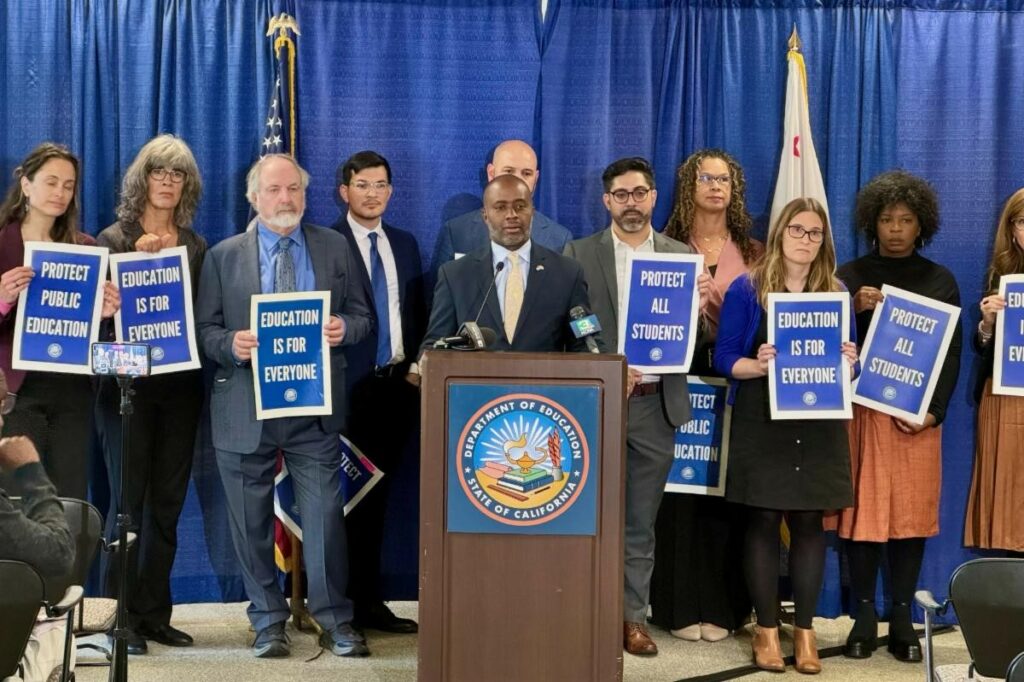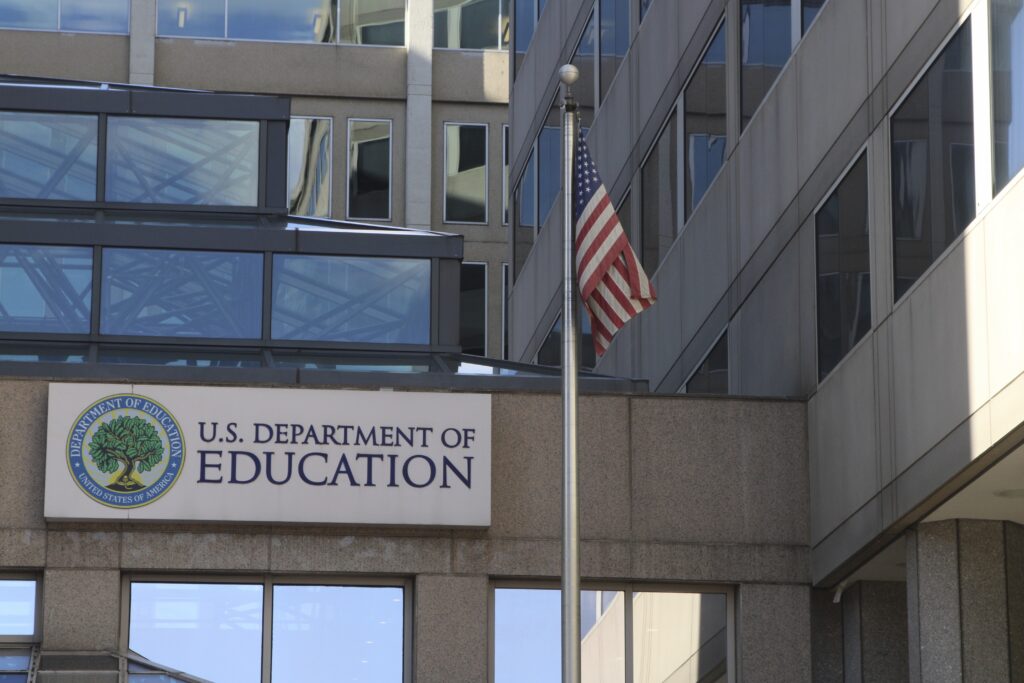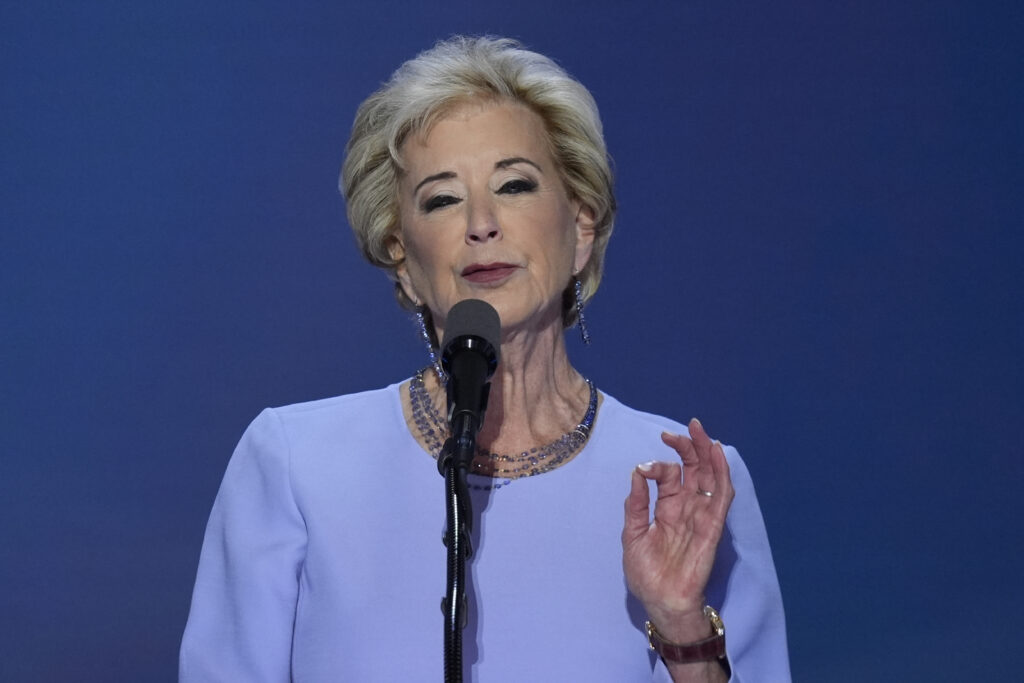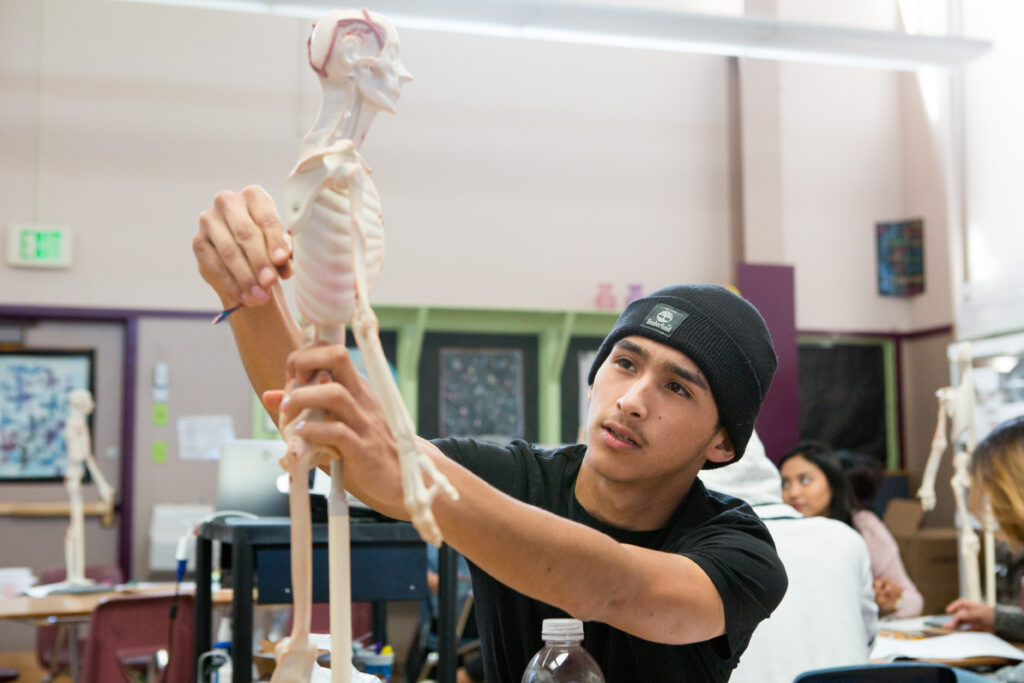
In this Jan. 25, 2017, file photo, protesters rally outside of City Hall in San Francisco in the wake of Donald Trump’s first election as president..
Credit: AP Photo/Jeff Chiu,file
Este artículo está disponible en Español. Léelo en español.
When Alejandra Lopez saw swing states that had gone for Joe Biden in 2020 leaning red for Donald Trump on Tuesday night, it felt like déjà vu.
“I was really distraught. Honestly, I really would have never thought I would see him having a second term in office,” said Lopez, who is a second-year political science student at Cal Poly Pomona.
For Lopez, the stakes were personal. Both of her parents are undocumented immigrants from Mexico who have lived in the U.S. for almost 20 years. Trump has pledged to enact mass deportation of undocumented immigrants.
When Trump won for the first time in 2016, Lopez was 11 years old. She remembers feeling scared that her parents — or even she, a U.S. citizen — would be deported and crying all day in class. Now, she feels more angry.
“I’m angry that he was elected into office again, that he has promised the same thing again, and that people keep perpetuating it and moving it forward, not recognizing how harmful it can be,” she said. “You look back, and you see that time and time again, he’s just rephrased the same hate that he’s spewed.”
Many California children and their families, including immigrants, transgender students and Black and Latino students, among others, are feeling similar fear and uncertainty, after the election of a candidate who has threatened to deport undocumented immigrants en masse, and to cut school funding to states that protect transgender students and promote diversity, equity and inclusion in their schools.
California education leaders and advocates said the fear is palpable and justifiable, but they also urged TK-12 schools, colleges and universities to make sure students and families know about policies to protect their rights, some of which were enacted during the first Trump administration.
An estimated 1 million California children — about 1 in 10 — have an undocumented immigrant parent, the state estimates. Many more have undocumented family members. About 165,000 California students are recent immigrants themselves.
“If we thought teaching was hard yesterday, wait for today’s questions like, “Is Trump going to send me back to the gangs?” and “Is he going to deport my mother/father/brother/cousin?” wrote teacher Larry Ferlazzo on X (formerly Twitter) Wednesday.
Xilonin Cruz-González, deputy director of the advocacy organization Californians Together, said schools must reach out now to immigrant families to ensure they feel welcome and safe in school.
“Even though it feels scary, especially for immigrant families, because of the rhetoric we’ve heard through the election cycle and we anticipate we will continue to hear, it’s important to remember, especially in California, we have legal protections for immigrant students,” Cruz-González said. “We have federal protections that require us to make sure our schools are safe and welcoming for all students. And we have California laws, especially AB 699, that was passed in 2017, that requires school districts to ensure that our immigrant students are welcomed into our public schools.”
The U.S. Supreme Court established in 1982, in the case Plyler vs. Doe, that all children have a right to a free public education, regardless of their immigration status.
California’s Assembly Bill 699 was passed in response to the previous Trump administration’s immigration enforcement and the fear it caused among immigrant families in California. The bill instructs schools not to collect information about families’ immigration status unless required by law, and requires schools to pass policies limiting assistance with immigration enforcement at public schools, among other things.
Lindsey Bird was a newcomer teacher, working with recent immigrant students in 2016 when Trump was first elected. She said she had Syrian refugee students in tears that day.
“They felt like their humanity was on the ballot, and they lost,” she said.
Bird now works with Teach Plus California, coaching teachers throughout the state on how best to teach English learners. She said teachers are “heartbroken” for their students after Tuesday’s election and eager to share information with their students about their rights.
“One teacher told me, ‘I’ll let myself grieve for the remainder of the week, but then I feel like my mama bear mode has been activated because I feel like I have to protect my students,’” Bird said. “So she was asking, ‘How can I protect them? What are my rights? What are their rights?’”
Megan Stanton-Trehan, a senior attorney at Disability Rights California who represents students with disabilities, said she saw many students with disabilities and students of color struggle during the last Trump presidency.
“I am really concerned about my clients who have disabilities, who are students of color, who are transgender,” said Stanton-Trehan. “In California, we may have a state that is protecting those students to some degree. We have laws that protect them here that are not dependent upon the way the federal government interprets the law, but that’s a lot of burden to put on the state.”
She said that the lessons of that first term, however, are in the power of people standing up to such policies.
“I think it’s definitely more than ever a time to really center those students and their needs and, really, their voices too,” Stanton-Trehan said. “They’re the next generation, and they’re living through this as well. They’re the ones at the forefront. If there’s any silver lining, it’s perhaps how galvanizing this can be for young people to say enough is enough.”
State Attorney General Rob Bonta has said that his team is preparing to protect immigrants, transgender students and others, with possible litigation against Trump’s expected policies.
“Fortunately, and unfortunately, we have four years of Trump 1.0 under our belts. We know what to expect, and we won’t be caught flat-footed,” said a Bonta spokesperson. “California’s Legislature has enacted strong protections for the rights of all students in California, and the Department of Justice will ensure those protections are enforced across the state. We are paying attention to what Trump and his advisers have said about their plans for a second administration, and we will be prepared to defend California’s values.”
U.C. Berkeley political science professor Dan Schnur said Gov. Gavin Newsom has battled Trump before, but faces a new reality with Harris’ loss.
“Newsom’s challenge is going to be balancing what’s best for him as governor and what’s best for him as a potential presidential candidate,” Schnur said.
And Trump recognizes, Schnur said, “how much he can benefit politically with his base by beating up on California. The question is how he decides how much of that political benefit can be realized by threats and how much can be realized through follow-up on those threats.”
Trump’s campaign promise of shutting down the U.S. Department of Education is an example.
Such a move “is a long, long, long shot,” Schnur said “Even if Republicans do win a House majority, he’s going to have a lot of members here who are reluctant to cast that vote.”
But Trump’s railing against transgender people and false claims that children receive gender reassignment surgeries at public schools may keep political traction, Schnur said.
“I think that debate is much more likely to be central to his agenda.”
LGBTQ+ youth were a major focus of this election season up and down the ballot, according to Jorge Reyes Salinas, communications director for LGBTQ+ civil rights organization Equality California.
Trump attacked transgender women playing sports and gender-affirming care for transgender youth. Local school board candidates promoted policies that outed transgender students to their parents, in opposition to a new state law. Anti-bullying policies at local school districts that specifically name LGBTQ youth have become a flash point.
California already has laws on the books that protect these communities, and Salinas noted that voters supported Proposition 3, which enshrines the right to same-sex marriage.
“I think being in California does provide a peace of mind,” Salinas said.
Equality California will be working with other organizations to ensure that there are no gaps in protecting LGBTQ+ youth in California, and that state laws that do support them are implemented.
Some school districts, including Los Angeles Unified, sent messages out to parents prior to or during Election Day, highlighting protections for students and offering mental health support for students experiencing anxiety or fear after the election.
The union representing teachers in LAUSD, United Teachers Los Angeles, issued a statement saying that “Ensuring that students and their families are informed and safe will always be our top priority. We are committed to ensuring that every LAUSD student, especially BIPOC, immigrant, and LGBTQIA+ students, has access to the education, resources, and support they deserve.”
Some colleges and universities sent similar messages to students. Santa Monica College sent a message to students before the election to offer counseling and “debriefing” spaces for all students, but particularly for LGBTQ students, undocumented students and “racially minoritized communities.” In a Nov. 6 message, San Francisco State University President Lynn Mahoney encouraged students to seek support from campus counseling services as well as groups including the Dream Resource Center and the Queer & Trans Resource Center.
Higher education officials in California are well aware they could face legal and funding challenges from the Trump administration on such issues as enrolling undocumented students, free speech and diversity, equity and inclusion. In a rare move Wednesday, the leaders of California’s three public higher education systems shared a joint statement emphasizing that their campuses are welcoming to students and staff from all backgrounds.
“Following the presidential election results, we understand that there is a great deal of uncertainty and anxiety within California’s higher education community,” reads the statement, which was signed by Michael Drake, president of the University of California; Mildred García, chancellor of the California State University; and Sonya Christian, chancellor of California Community Colleges.
“The University of California, the California State University, and the California Community Colleges remain steadfast and committed to our values of diversity and inclusivity,” they added.
Ju Hong, director of the UCLA Dream Resource Center, said Trump’s call for mass deportation is stoking fear among undocumented students and students who are citizens but have family members who are undocumented.
Hong said there’s also concern that the Deferred Action for Childhood Arrivals, or DACA, program could get terminated by the courts during Trump’s presidency. Hong himself is a DACA recipient. If the program gets terminated, he wouldn’t be able to keep his job and would be at risk of deportation.
Hong called on UC leaders, including the system’s board of regents, to support immigrant students and staff, both with public statements of support and by advocating for more funding for programs like the Dream Resource Center.
“Hopefully they think through what are some creative ways to proactively support immigrant students on and off campus,” Hong said.
Kevin R. Johnson, professor and former dean of the UC Davis School of Law, said he is concerned that the election of Trump to a second presidency could deter undocumented students from attending public universities, even in California, where they are eligible for in-state tuition and where all three public college and university systems have legal services for undocumented students and family members.
“I do think that over the next few months, we will see a great deal of fear and consternation in the immigrant community, including the immigrant student community,” Johnson said. “I fear that the general tenor and thrust of President Trump and some others about immigrants can chill undocumented students from attending a public university and be worried that any appearance in public places could lead to their removal.”



















